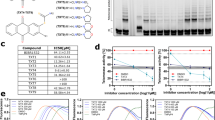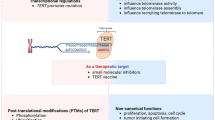Abstract
Human telomerase is absent in most normal tissues, but is abnormally activated in all major cancer cells. Telomerase enables tumor cells to maintain telomere length, allowing indefinite replicative capacity. Albeit not sufficient in itself to induce neoplasia, telomerase is believed to be necessary for cancer cells to grow without limit. Studies using an antisense oligonucleotide (ASODN) to the RNA component of telomerase or human telomerase reverse transcriptase (hTERT) demonstrate that telomerase in human tumor lines can be blocked in vivo. Inhibition of hTERT led to telomere shortening and cancer cell death, validating telomerase as a target for anticancer genetic therapy. Varieties of approaches for hTERT inhibition have been investigated. The aim of this study was to analyze the biological activity of ASODN to the hTERT mediated by retrovirus vector, which was used as therapy for ovarian tumor. We constructed and characterized a recombinant retrovirus vector with full-length hTERT antisense complementary DNA. The vector was introduced into ES-2 by lipofectamine-mediated gene transfection. The cellular proliferation and telomerase activity of the transformant cells were retarded. The hTERT gene expression and the telomerase activity of the transformant cells were both decreased. The transformant cells show partial reversion of the malignant phenotype. PT67 cells were also transfected with the recombinant vector and virus-producer cells were generated. The retrovirus-containing supernatant effectively inhibited the growth of human ovarian tumor xenografts in mouse models (subcutaneous tumor model), and enhanced the mouse survival time.
This is a preview of subscription content, access via your institution
Access options
Subscribe to this journal
Receive 12 print issues and online access
$259.00 per year
only $21.58 per issue
Buy this article
- Purchase on Springer Link
- Instant access to full article PDF
Prices may be subject to local taxes which are calculated during checkout






Similar content being viewed by others
References
Nittis T, Guittat L, Stewart SA . Alternative lengthening of telomeres (ALT) and chromatin: is there a connection? Biochimie 2008; 90: 5–12.
Rao YK, Kao TY, Wu MF, Ko JL, Tzeng YM . Identification of small molecule inhibitors of telomerase activity through transcriptional regulation of hTERT and calcium induction pathway in human lung adenocarcinoma A549 cells. Bioorg Med Chem 2010; 18: 6987–6994.
Hiyama E, Hiyama K . Telomerase as tumor marker. Cancer Lett 2003; 194: 221–233.
Hodes R . Molecular targeting of cancer: telomeres as targets. Proc Natl Acad Sci USA 2001; 98: 7649–7651.
Zhang RG, Wang XW, Yuan JH, Xie H . Human hepatoma cell telomerase activity inhibition and cell cycle modulation by its RNA component antisense oligodeoxyribonucleotides. Acta Pharmacol Sin 2000; 21: 742–746.
Kim NW, Piatyszek MA, Prowse KR, Harley CB, West MD, Ho PL et al. Specific association of human telomerase activity with immortal cells and cancer. Science 1994; 266: 2011–2015.
Bellon M, Nicot C . Regulation of telomerase and telomeres: human tumor viruses take control. J Natl Cancer Inst 2008; 100: 98–108.
Naka K, Yokozaki H, Yasui W, Tahara H, Tahara E, Tahara E . Effect of antisense human telomerase RNA transfection on the growth of human gastric cancer cell lines. Biochem Biophys Res Commun 1999; 255: 753–758.
Mukai S, Kondo Y, Koga S, Komata T, Barna BP, Kondo S . 2-5A antisense telomerase RNA therapy for intracranial malignant gliomas. Cancer Res 2000; 60: 4461–4467.
Jiang YA, Luo HS, Fan LF, Jiang CQ, Chen WJ . Effect of antisense oligodeoxynucleotide of telomerase RNA on telomerase activity and cell apoptosis in human colon cancer. World J Gastroenterol 2004; 10: 443–445.
Yuan Z, Mei HD . Inhibition of telomerase activity with hTERT antisense increases the effect of CDDP-induced apoptosis in myeloid leukemia. Hematol J 2002; 3: 201–205.
Sekaran VG, Soares J, Jarstfer MB . Structures of telomerase subunits provide functional insights. Biochim Biophys Acta 2010; 1804: 1190–1201.
Donate LE, Blasco MA . Telomeres in cancer and ageing. Philosophical transactions of the Royal Society of London. Series B. Biol Sci 2011; 366: 76–84.
Zvereva MI, Shcherbakova DM, Dontsova OA . Telomerase: structure, functions, and activity regulation. Biochemistry 2010; 75: 1563–1583.
Folini M, Brambilla C, Villa R, Gandellini P, Vignati S, Paduano F et al. Antisense oligonucleotide-mediated inhibition of hTERT, but not hTERC, induces rapid cell growth decline and apoptosis in the absence of telomere shortening in human prostate cancer cells. Eur J Cancer 2005; 41: 624–634.
Kraemer K, Fuessel S, Schmidt U, Kotzsch M, Schwenzer B, Wirth MP et al. Antisense-mediated hTERT inhibition specifically reduces the growth of human bladder cancer cells. Clin Cancer Res 2003; 9: 3794–3800.
Yu HP, Xu SQ, Lu WH, Li YY, Li F, Wang XL et al. Telomerase activity and expression of telomerase genes in squamous dysplasia and squamous cell carcinoma of the esophagus. J Surg Oncol 2004; 86: 99–104.
Yang Y, Chen Y, Zhang C, Huang H, Weissman SM . Nucleolar localization of hTERT protein is associated with telomerase function. Exp Cell Res 2002; 277: 201–209.
Meeker AK, De Marzo AM . Recent advances in telomere biology: implications for human cancer. Curr Opin Oncol 2004; 16: 32–38.
Killedar A, Stutz MD, Sobinoff AP, Tomlinson CG, Bryan TM, Beesley J et al. A common cancer risk-associated allele in the hTERT locus encodes a dominant negative inhibitor of telomerase. PLoS Genet 2015; 11: e1005286.
Ruden M, Puri N . Novel anticancer therapeutics targeting telomerase. Cancer Treat Rev 2013; 39: 444–456.
Akhtar S, Hughes MD, Khan A, Bibby M, Hussain M, Nawaz Q et al. The delivery of antisense therapeutics. Adv Drug Deliv Rev 2000; 44: 3–21.
Phatak P, Burger AM . Telomerase and its potential for therapeutic intervention. Br J Pharmacol 2007; 152: 1003–1011.
Cunningham AP, Love WK, Zhang RW, Andrews LG, Tollefsbol TO . Telomerase inhibition in cancer therapeutics: molecular-based approaches. Curr Med Chem 2006; 13: 2875–2888.
Harley CB . Telomerase and cancer therapeutics. Nat Rev Cancer 2008; 8: 167–179.
Roth A, Harley CB, Baerlocher GM . Imetelstat (GRN163L)—telomerase-based cancer therapy. Recent Results Cancer Res 2010; 184: 221–234.
Tao M, Miyano-Kurosaki N, Takai K, Takaku H . Specific inhibition of human telomerase activity by transfection reagent, FuGENE6-antisense phosphorothioate oligonucleotide complex in HeLa cells. FEBS Lett 1999; 454: 312–316.
Lee LK, Roth CM . Antisense technology in molecular and cellular bioengineering. Curr Opin Biotechnol 2003; 14: 505–511.
Morgan B, Thomas AL, Drevs J, Hennig J, Buchert M, Jivan A et al. Dynamic contrast-enhanced magnetic resonance imaging as a biomarker for the pharmacological response of PTK787/ZK 222584, an inhibitor of the vascular endothelial growth factor receptor tyrosine kinases, in patients with advanced colorectal cancer and liver metastases: results from two phase I studies. J Clin Oncol 2003; 21: 3955–3964.
Stein CA, Neckers LM, Nair BC, Mumbauer S, Hoke G, Pal R . Phosphorothioate oligodeoxycytidine interferes with binding of HIV-1 gp120 to CD4. J Acquir Immune Defic Syndr 1991; 4: 686–693.
Sharkey FE, Fogh J . Considerations in the use of nude mice for cancer research. Cancer Metastasis Rev 1984; 3: 341–360.
Wong SC, Lo ES, Chan AK, Lee KC, Hsiao WL . Nuclear beta catenin as a potential prognostic and diagnostic marker in patients with colorectal cancer from Hong Kong. Mol Pathol 2003; 56: 347–352.
Kondo S, Tanaka Y, Kondo Y, Hitomi M, Barnett GH, Ishizaka Y et al. Antisense telomerase treatment: induction of two distinct pathways, apoptosis and differentiation. FASEB J 1998; 12: 801–811.
Fan XK, Yan RH, Li BJ, Chen XM, Wei L, Wang Z . Antisense oligodeoxynucleotide against human telomerase reverse transcriptase inhibits the proliferation of Eca-109 esophageal carcinoma cells. Exp Ther Med 2014; 8: 1247–1252.
Author information
Authors and Affiliations
Corresponding author
Ethics declarations
Competing interests
The authors declare no conflict of interest.
Rights and permissions
About this article
Cite this article
Qi, Z., Mi, R. Inhibition of human telomerase reverse transcriptase in vivo and in vitro for retroviral vector-based antisense oligonucleotide therapy in ovarian cancer. Cancer Gene Ther 23, 36–42 (2016). https://doi.org/10.1038/cgt.2015.64
Received:
Revised:
Accepted:
Published:
Issue Date:
DOI: https://doi.org/10.1038/cgt.2015.64



